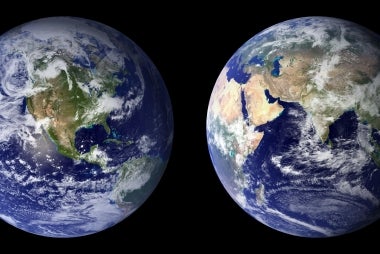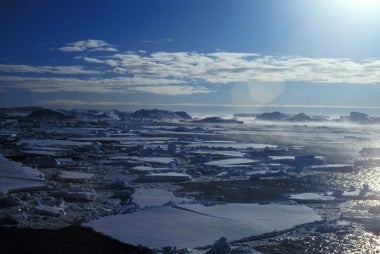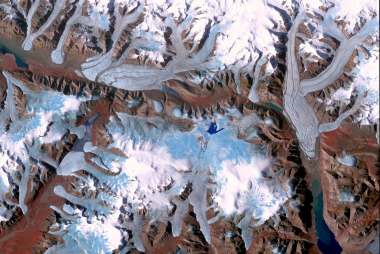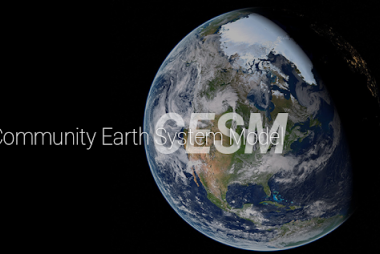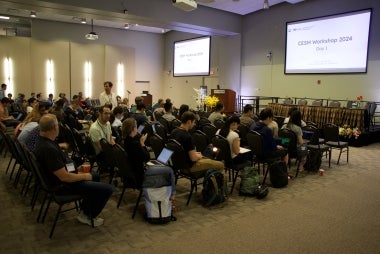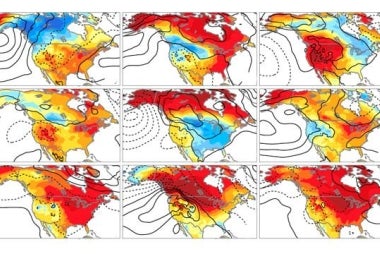January 2024 Newsletter

|
Welcome to our second quarterly Community Earth System Model (CESM) Newsletter. Want to receive our next newsletter in your inbox? Visit our newsletter page to subscribe and never miss a newsletter.
In this Newsletter:
Chief Scientist Message
AGU Updates
Upcoming Meetings
Research Highlights from our Community
Technology Updates
Quick Links
Chief Scientist Message
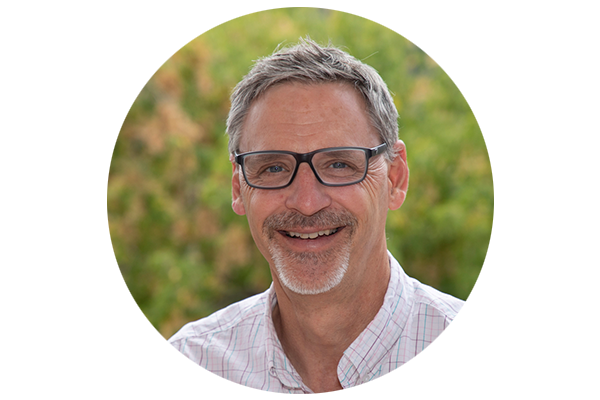
|
Happy New Year and welcome to the 2nd edition of the CESM Newsletter. I am enthusiastic about the forthcoming year for the CESM project as we work towards finalizing the scientific features and capabilities of CESM3. February and early March is the CESM Winter Working season (see registration information below) and we look forward to seeing many of you in person or virtually at these important meetings. This year, a particular focus of many of the Working Group meetings will be on final deliberations on what will be included in the CESM3 release version of the model. Please join us to help us make these important decisions, to share your model development plans and progress, and to get caught up on the wide ranging CESM Working Group activities and planning related to topics such as Earth System interactions, the potential for machine learning to advance models faster, Earth System prediction across time and space scales, climate intervention strategies, computational infrastructure in an ever-changing computational and user-needs environment, and more.
To kick off this newsletter, I want to highlight a successful CESM presence at the 2023 AGU Annual Meeting. The impact of CESM on Earth system science was apparent throughout the meeting. An unofficial search of the 2024 AGU abstracts database turned up nearly 400 abstracts that reference CESM or its component models, which is a testament to all the great and impactful science that our research community is doing. And, CESM scientists were involved in organizing several Town Halls, including two that are highlighted here on Idealized Modeling and Climate Justice.
Idealized Modeling with CESM
On the Friday lunchtime of AGU, members of CGD organized a Townhall on idealized modeling within CESM. The purpose of this Townhall was to provide updates on the idealized model configurations that are currently available within the CESM framework and to inform participants about new idealized modeling tools that are in the development pipeline as well as to have an open discussion on community needs when it comes to idealized modeling within CESM. The Townhall was well attended, despite being during the last lunchtime of AGU. For those who missed it, you can find out what idealized modeling capabilities are currently available on the CESM simpler models page (see also Figure 2 for a graphic highlighting the currently available and planned atmospheric modeling hierarchy). New developments to look out for in the coming year are a toolkit for configuring coupled idealized model configurations with user-defined continental geometries, ocean bathymetry, and land surface properties, as well as the release of the Simple Land Interface Model of Laguë, et al (2019) that can be used to specify idealized land properties such as albedo, evaporative resistance, or surface roughness to evaluate how the atmosphere responds to specific land processes.
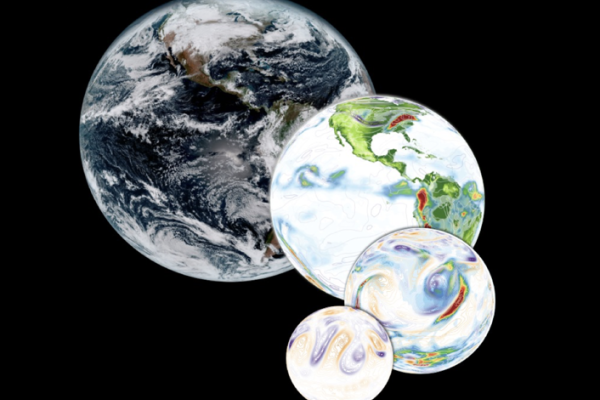
|
Figure 1 from Polvani et al., (2017)
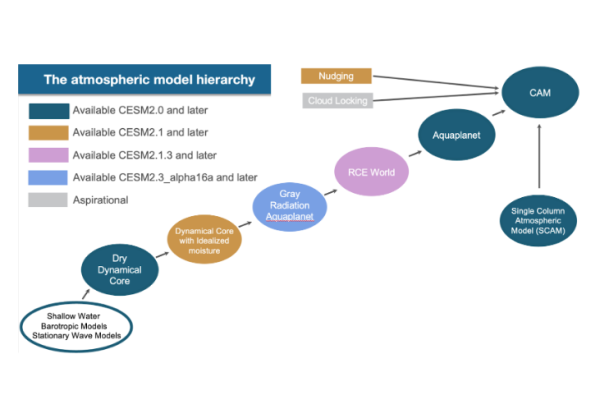
|
Figure 2 - A graphic highlighting the currently available and planned atmospheric modeling hierarchy
Climate Justice
On Monday at AGU, Monica Ainhorn Morrison and Gokhan Danabasoglu hosted a Townhall dedicated to discussing the CESM Climate Justice Task Team plans with members of the AGU community. The Climate Justice Task Team aims to bring awareness to issues at the intersection of climate change and justice to the climate modeling community. A primary goal is to increase representation of the values, perspectives, and priorities of historically marginalized and climate vulnerable populations. The purpose of the Townhall was to engage the wider community in discussions on how to make progress in our modeling practices in relation to environmental and climate justice concerns.
Townhall participants were enthusiastic about the effort and had thoughtful suggestions for the Task Team to consider, including: 1) increasing the availability and accessibility of the model and model output to graduate students, early-career, and non-English speakers, and working with TCUs, MSIs, and HBCUs to build capacity for working CESM, 2) designing frameworks to bring different ways of knowing together in the context of modeling, 3) reorienting model applications to focus more on learning how to withstand climate impacts by developing resilience, and 4) increasing the accessibility of the model output and providing readily available information on how to best utilize CESM community products. Work will continue through ongoing discussions about how we can co-create meaningful and respectful engagement between climate modelers and traditionally marginalized communities harmed by epistemic and climate injustice and scientific inequities and bring their perspectives into the modeling space.
Moving forward, we plan to have a virtual Climate Justice Task Force meeting and discussion during the Winter Working group meeting season (Friday February 23, see below for registration link), and are looking to partner with members of the CESM community to develop a Cross-Working group session at the 2024 CESM Annual Workshop. If you are interested in collaborating on this effort, please email Monica Morrison.
Upcoming Meetings
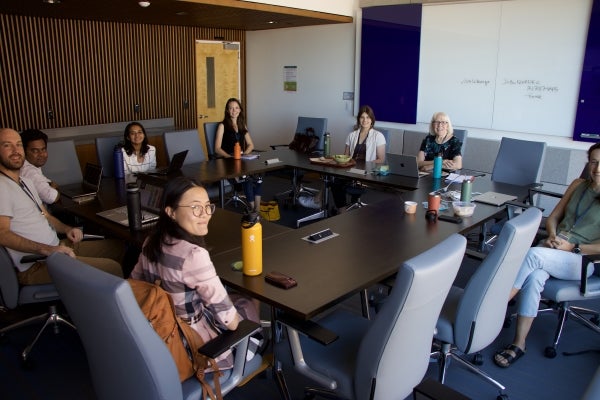
|
CESM Working Group Meetings 2024:
The CESM Working Group Meetings will take place from February 5th to March 7th, 2024. The meetings will be held at the NSF National Center for Atmospheric Research in Boulder, CO. Specific dates are as follows:
Land Ice and Polar Climate Working Group Meeting: February 5th - February 7th, 2024
Ocean Model Working Group Meeting: February 7th - February 8th, 2024
Atmosphere Model, Chemistry Climate, and Whole Atmosphere Working Group Meeting : February 12th - February 13th, 2024
Climate Justice Task Force : Zoom : February 23rd, 2024
Paleoclimate Working Group Meeting: February 26th, 2024
Land Model and Biogeochemistry Working Group Meeting: February 27th - February 29th, 2024
Software Engineering Working Group Meeting: March 4th, 2024
Earth System Prediction Working Group Meeting: March 5th, 2024
Climate Variability and Change Working Group Meeting: March 6th, 2024
Earth System Predictability Across Timescales Workshop
What to expect: The scope of the workshop will include predictability and prediction across Earth systems (atmosphere, ocean, land, sea ice, geospace, terrestrial and marine ecosystems) spanning timescales of minutes to days, subseasonal to seasonal, seasonal to decades, and decades to centuries. Workshop participants will establish and identify:
-Key scientific questions
-Needs for community modeling and analysis tools
-Opportunities for better integration of observations and modeling
-Engagement with interested communities
-Partnership opportunities
Date and Location: April 10 - 12, 2024 - NSF NCAR’s Center Green Campus, Boulder, Colorado, and online
How to Register: We’re looking for participants who are, or who want to be, engaged in answering frontier science questions related to Earth system predictability from across disciplines and have interest in partnering with NSF NCAR in this research. We invite NSF NCAR and the external community to shape this effort. Fill out this web form to receive future updates about event registration and agenda.
CESM Workshop
The 29th annual CESM Workshop will take place from June 10th to June 13th, 2024 in Boulder, CO. More information will be announced on this page as the workshop approaches.
CESM Tutorial
The 2024 CESM Tutorial will take place August 5-9, 2024 and the application is now open.
The CESM Tutorial will consist of lectures on simulating the climate system, practical sessions on running CESM, modifying components, and analyzing data, small group discussions with CESM scientists, and student networking.
The CESM tutorial is targeted to individuals with no or little experience with CESM. It provides attendees with a solid scientific understanding of the CESM components and the basic building blocks to start running the model. We welcome applications from students, postdocs, research scientists, and faculty members, especially from individuals whose research/career would benefit from using CESM.
Format: The 2024 CESM Tutorial is an in-person event. Specific details regarding the content and format will be posted to the webpage as soon as they become available.
Cost: There is no cost to apply or to attend the tutorial. At this time we do not know if NSF NCAR can provide travel support to attendees. Further details will be posted to the webpage as they become available.
Deadlines: The application deadline is February 4, 2024, at 11:59 PM Mountain Time. Accepted students will be informed by April 19, 2024. Please be aware that the tutorial acceptance process is competitive; historically, approximately 1 out of 2 applicants were accepted. Therefore, it is advisable to carefully compose and review your application before submission.
We are committed to welcoming all applicants and fostering an inclusive environment free from discrimination.
Research Highlights from Our Community
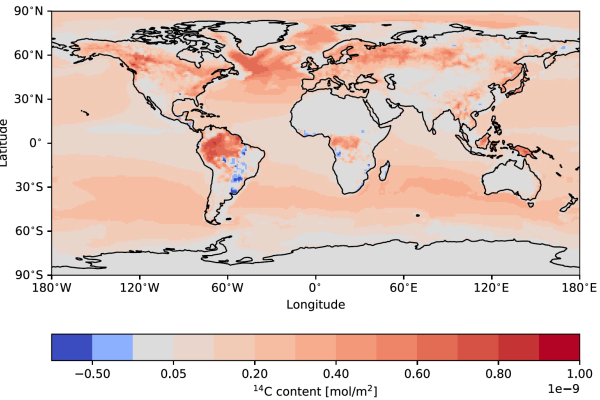
|
Figure: Changes in the 14C column inventory in the ocean and on land from 1945 to 1995 simulated by Parallel Ocean Model version 2 with Normal Year Forcing and Community Land Model, version 5.0 from the research article below.
Radiocarbon in the land and ocean component of the Community Earth System Model
A research article by Tobias Frischknect, Altug Ekici, and Fortunant Joos. See the abstract below:
Large amounts of the carbon-isotope 14C, entering Earth's carbon cycle, were produced in the atmosphere by atomic bomb tests in the 1950s and 1960s. Frischknecht et al., 2022, forced the ocean and land components of the Community Earth System Model with atmospheric 14CO2 over the historical period to constrain overturning time scales and fluxes. The uptake of bomb 14C by the land model is lower than observation-based estimates. This mismatch is likely linked to too-low 14C uptake by vegetation as the model overestimates 14C/C ratios of modern soils. This suggests model biases in forest productivity or wood carbon allocation and turnover, and, in turn, a bias in the forest sink of anthropogenic carbon. The ocean model matches the observation-based global bomb 14C inventories when applying the quadratic relationship between gas transfer piston velocity and wind speed of Wanninkhof (2014) and the wind products from Large and Yeager or the Japanese Reanalysis Project. Simulated natural radiocarbon ages in the deep ocean are many centuries older than data-based estimates, indicating too slow deep ocean ventilation. The sluggish circulation causes large biases in biogeochemical tracers and implies a delayed deep ocean uptake of heat and carbon in global warming projections. Our study suggests that 14C observations are key to constrain carbon fluxes and transport timescales for improved representations of land and ocean biogeochemical cycles and Earth system model projections.
How the Great Plains Dust Bowl drought spread heat extremes around the Northern Hemisphere
A publication by Gerald A. Meehl (National Center for Atmospheric Research), Haiyan Teng (Pacific Northwest National Laboratory), Nan A Rosenbloom (National Center for Atmospheric Research), Aixue Hu (National Center for Atmospheric Research), Claudia Tebaldi (Pacific Northwest National Laboratory), and Guy Walton (Weather Channel). See the abstract below:
Extraordinary heat extremes occurred in the 1930s in areas of the Northern Hemisphere far from the record setting heat over the US associated with the Great Plains Dust Bowl drought. A climate model sensitivity experiment is used to identify a new mechanism involving a warm season circumglobal atmospheric teleconnection pattern that spread heat extremes over far-flung areas of the Northern Hemisphere arising from the intense heating over the desiccated Great Plains themselves. It has only been in the twenty-first century that human populations in these regions of the Northern Hemisphere have experienced heat extremes comparable to the 1930s. This demonstrates that humans influenced Northern Hemisphere temperature and heat extremes through disastrous and unprecedented regional land use practices over the Great Plains, and points to the possibility that future intense regional droughts could affect heat extremes on hemispheric scales.
See additional recent publications below:
Climate Response of Abrupt and Steady Stratospheric Aerosol Injection
A New Explanation of the Mechanism of Hadley Circulation
Drivers of Future Extratropical Sea Surface Temperature Variability Change in the North Pacific
Technology Updates
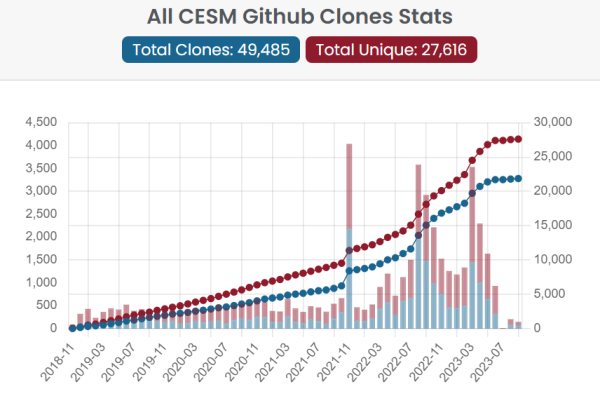
|
Metrics Tracker:
We have an updated version of our metrics tracker which includes up to date metrics for the CESM GitHub repository, SVN repositories, and user support forums. You can see how many community members have been using various software as well as narrow down date ranges for in depth metrics.
Availability of CESM2-CMIP5 Community Ensemble Simulations:
Simulations of CESM2 which use external forcing that is consistent with the CMIP5-forcing protocol are available for community use. This includes a pre-industrial control run and fifteen 20th-21st century ensemble members. The forcing used in these simulations is equivalent to that used in the CESM1 Large Ensemble. These new simulations allow for studies on the role of forcing uncertainty in simulated climate and enable separation of the role of model structural and model forcing differences in comparisons of the CESM1 and CESM2 Large Ensembles. More information on the experimental design and simulation availability can be found on this webpage.
A paper has just been accepted that describes these runs.
CESM2.1.5 and CESM2.2.2 Available
CSEG is pleased to announce that new release tags are available for cesm2.1.5 and cesm2.2.2. Please view the CESM2 page to learn more.
Google Groups Update:
Our mailman email lists have been renamed and updated, for more information and to sign up for the new groups please visit this webpage to learn more.
CGD Youtube Channel Subscription:
The CGD YouTube channel frequently streams and posts CESM workshop and tutorial videos, seminars, etc. If you want to follow along, visit our YouTube page and select Subscribe at the top of the page.
Quick Links
CGD X Account
CGD Youtube Channel
CESM User Support Forum
CVCWG Simulations
Simpler Models Information
Thanks for reading this CESM Newsletter! Expect to see the next one in May of 2024. Please send potential Newsletter items to Elizabeth Faircloth.
